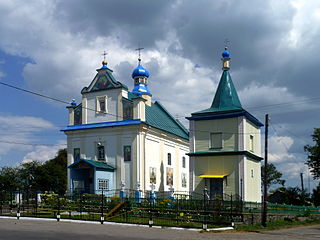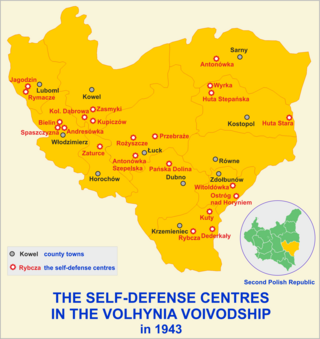
The Massacres of Poles in Volhynia and Eastern Galicia were carried out in German-occupied Poland by the Ukrainian Insurgent Army (UPA), with the support of parts of the local Ukrainian population, against the Polish minority in Volhynia, Eastern Galicia, parts of Polesia, and the Lublin region from 1943 to 1945.

Kovel is a city in Volyn Oblast, northwestern Ukraine. It serves as the administrative center of Kovel Raion within the oblast. Population: 67,575.

Wołyń Voivodeship or Wołyń Province was an administrative region of interwar Poland (1918–1939) with an area of 35,754 km², 22 cities, and provincial capital in Łuck.

Pavlivka is a town now located in northwestern Ukraine, in Volodymyr Raion of Volyn Oblast, near Volodymyr, on the Luha river. For centuries, Poryck was property of several noble Polish families. The town is the birthplace of a Polish statesman Tadeusz Czacki. On 11 July 1943, the Ukrainian Insurgent Army, supported by local nationalists murdered here more than 300 Polish civilians, who had gathered in a local Roman Catholic church for a Sunday ceremony.

The Defence of Przebraże was fought between the Ukrainian Insurgent Army against the Polish Self–Defense, Home Army and Soviet partisans in the Łuck County of the Wołyń Voivodeship. The Northern Operational Group under the command of Dmytro Klyachkivsky and 3rd Operational Group "Turiv" under the command of Yuriy Stelmaschuk tried four times to destroy and conquer the largest Polish Self–Defense base and center in the Volhynia, but the UPA didn't succeed.
Dominopol is a defunct village located in the present-day area of Volodymyr-Volynskyi Raion of Volyn Oblast in Ukraine. On July 11, 1943, at the height of the Massacres of Poles in Volhynia, the village was attacked by a death squad of Ukrainian Insurgent Army aided by the Ukrainian peasants, and all ethnic Poles regardless of age and gender were tortured and murdered. Before World War II, Dominopol was a village in the Eastern regions of the Second Polish Republic, located in the Gmina Werba, Powiat Włodzimierz of the Wołyń Voivodeship. The area was invaded by the Soviet Union in 1939 and during Operation Barbarossa annexed by Nazi Germany into Reichskommissariat Ukraine in 1941.
The village of Adamy was burned to the ground during the Massacres of Poles in Volhynia and Eastern Galicia, and no longer exists. It was destroyed by the Ukrainian Insurgent Army aided by the Ukrainian peasants who set ablaze 200 Polish farms and murdered whomever they could find. Adamy was located in powiat Kamionka Strumiłowa (county) near Busk in the Tarnopol Voivodeship of the Second Polish Republic before the Nazi-Soviet invasion of Poland in 1939.

Bortnytsia is a village in Rivne oblast, near the town of Dubno, in Dubno Raion, Ukraine. The village currently has a population of 365.
Pańska Dolina was a Polish village. The village was liquidated during the Polish population transfers after World War II, when the Kresy macroregion was formally incorporated into the Soviet Union. Pańska Dolina used to be located in Gmina Młynów, Powiat Dubno (county), of the Wołyń Voivodeship, before the Nazi German and Soviet invasions of Poland in September 1939. Its former location can be found near Mlyniv in Dubno Raion of present-day Ukraine.

Józef Turowski was a Polish military historian.

The Podkamień massacre or the Pidkamin massacre of 12 March 1944 was the massacre of Polish civilians committed by the Ukrainian Insurgent Army (UPA) under the command of Maksym Skorupsky (Maks). The victims were ethnic Polish residents of Podkamień, Tarnopol Voivodeship. During the war the area was administratively part of the Nazi German Reichskommissariat Ukraine. Estimates of victims include 150, more than 250 and up to 1000.

On Sunday, 11 July 1943, OUN-UPA death squads, aided by local Ukrainian peasants, simultaneously attacked at least 99 Polish settlements within Wołyń Province of the German-occupied prewar Second Polish Republic. It was a well-orchestrated attack on people gathered at Catholic churches for Sunday mass. The towns affected included Kisielin, Poryck, Chrynów, Zabłoćce, and Krymn, while dozens of other towns were attacked on other dates; tens of churches and chapels were burned to the ground.
Chrynów massacre was a massacre of Polish worshipers which took place in the Volhynian village of Chrynów, Gmina Grzybowica, Powiat Włodzimierz, Wołyń Voivodeship of the Second Polish Republic. It took place on Sunday, July 11, 1943, when the Ukrainian Insurgent Army (UPA) as well as armed deserters from the Ukrainian Auxiliary Police, supported by local Ukrainian peasants, surrounded the local Roman-Catholic church where the Poles had gathered for a religious ceremony. The parish priest Jan Kotwicki was shot along with a group of women, when attempting to escape through the vestry. During the attack on the village Ukrainians murdered some 150 Poles. A week after these events all buildings in the village and the church were burned down to the ground, and the village ceased to exist.
The Wiązownica massacre occurred on 17 April 1945 in the village Wiązownica, located in Jarosław County Subcarpathian Voivodeship, in southeastern Poland, then located in Lwów Voivodeship. It was one of the Massacres of Poles in Volhynia and Eastern Galicia, and was perpetrated by the Ukrainian Insurgent Army (UPA). The massacre occurred during a battle fought between the UPA and, initially, local Polish partisans, and, later, the Polish People's Army (LWP), towards the outskirts of Wiązownica. It saw the deaths of 91 civilians, including 20 women and children, alongside four LWP soldiers. The UPA also burned down 150 houses. In retaliation for the attack, the LWP led an attack on the village Piskorowice, given its large concentration of Ukrainians sympathetic for OUN.
Hurby massacre was a mass murder of the Polish population of the Hurby village, perpetrated on June 2, 1943, by a death squad of the Ukrainian Insurgent Army (UPA) and so-called brushwood self defence commando made up of Ukrainian peasants, during the province-wide Massacres of Poles in Volhynia and Eastern Galicia in World War II. Hurby belonged to the Second Polish Republic before the war began. It used to be located in the powiat Zdobłunowski of the Wołyń Voivodeship. It is now a valley by the same name in western Ukraine. About 250 Poles were murdered in the attack, which was confirmed by the UPA commander for Volyn, Dmytro Klyachkivsky, who said in his communique of June 1943 that Hurby "went up in smoke".

Głęboczyca massacre was a mass murder of ethnic Poles carried out on 29 August 1943 by the troops of the Ukrainian Insurgent Army aided by the Ukrainian peasants. It exclusively targeted Polish inhabitants of the Głęboczyca colony, located in the Włodzimierz County of the Wołyń Voivodeship in the Second Polish Republic. About 250 Poles were killed, including 199 known by name including women and children. Głęboczyce does not exist anymore. It was swept from existence during the Massacres of Poles in Volhynia and Eastern Galicia, along with the neighbouring settlement of Ostrówek in powiat Luboml.

Budy Ossowskie massacre was a mass murder of ethnic Poles carried out on 29–30 August 1943 by a death squad of the Ukrainian Insurgent Army aided by the Ukrainian peasants during the Massacres of Poles in Volhynia and Eastern Galicia. About 290 people were killed, including women and children, all of them, Polish inhabitants of the Budy Ossowskie village, located in the Kowel County of the Wołyń Voivodeship in the Second Polish Republic. Budy Ossowskie village does not exist anymore. It was burned to the ground by the OUN-UPA. The charred remnants of the village were cleared in Soviet Ukraine for grazing cattle. Overall, in the Kowel County some 7,300 ethnic Poles were murdered.
Gurów massacre was a wartime massacre of the Polish population of Gurów, committed on 11 July 1943 by the Ukrainian Insurgent Army death squad from Group "Piwnicz" and Ukrainian peasants, during the Massacres of Poles in Volhynia and Eastern Galicia. The crime scene was the prewar village of Gurów located in Gmina Grzybowica, Powiat Włodzimierz in the Wołyń Voivodeship of the Second Polish Republic. Gurów village no longer exists.
Zagaje massacre was a mass murder of ethnic Poles carried out on 11–12 July 1943 by the troops of the Ukrainian Insurgent Army group "Piwnicz", aided by the Ukrainian peasants, during the Massacres of Poles in Volhynia and Eastern Galicia. Approximately 260–350 people were killed, including women and children. The village Zagaje was levelled out and does not exist anymore. It was located in the gmina Podberezie of the Horochów County in the Wołyń Voivodeship of the Second Polish Republic. Overall, in the Horochów County some 4,200 ethnic Poles were murdered, in nearly hundreds of separate locations before the end of the Polish-Ukrainian conflict. The village Zagaje is not to be confused with the Zagaje colony, located in gmina Czaruków, powiat Łuck, of the same voivodeship.












